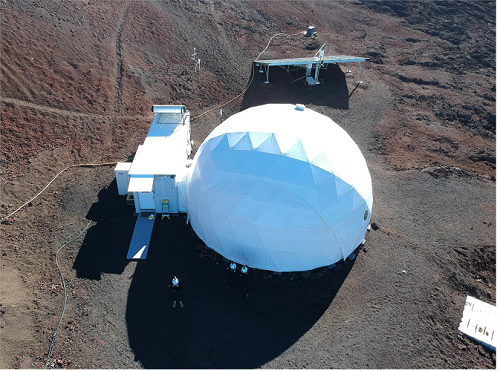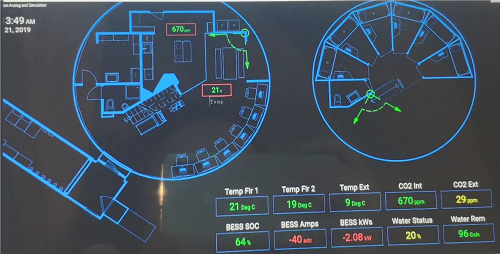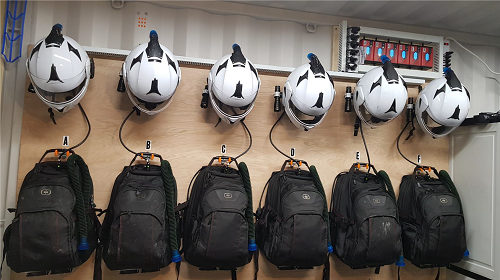EMMIHS-2 Analog Moonbase Viewpoint And Results – An Engineering Outlook at the Second Euro-MoonMars IMA HI-SEAS 2019 Campaign
- 1ILEWG EuroMoonMars programme
- 2EMMIHS (EuroMoonMars - International Moonbase Alliance - HI-SEAS)
- 3International Moonbase Alliance (IMA) & Hawai´i Space Exploration Analog and Simulation (HI-SEAS), United States
- 8Applied physics, Hague University of Applied Sciences, Delft
Introduction: The EuroMoonMars IMA HI-SEAS 2019 campaigns (EMMIHS) are field research campaigns, an initiative directed by the International Lunar Exploration Working Group (ILEWG) of the European Space Agency (ESA) in collaboration with the International MoonBase Alliance (IMA). The purpose of these campaigns is to conduct scientific experiments and test technological instruments relevant to space exploration and extraterrestrial habitation. The team for the second edition of this campaign consisted of six crewmembers, based at the Hawaii Space Exploration Analog and Simulation (HI-SEAS) [1] habitat with support from the Mission Control Centre (MCC), based at the Blue Planet Research Lab in Hawaii, and remote support based at EuroMoonMars ESA/ESTEC in Noordwijk, the Netherlands.
In 2019, the EuroMoonMars campaign was launched at HI-SEAS, bringing together researchers from the European Space Agency (ESA), IMA, the International Lunar Exploration Working Group (ILEWG), European Space Research and Technology Centre (ESTEC), VU Amsterdam and many other international organizations [2,3]. These campaigns aim to increase awareness about the research and technology testing that can be performed in analog environments in order to help humans become multi-planetary species.
Furthermore, the research and technological experiments conducted at HI-SEAS are going to be used to help build a Moon base in Hawai’i, and ultimately to create an actual Moonbase on the Moon, as part of IMA’s primary goals [6].
This paper will deliver details of the research projects conducted and an overview of the crew engineer’s routine. The paper will also present the challenges and outcomes of the mission and its activities from an engineering perspective.

Fig. 1 HI-SEAS habitat view. The picture was taken during an EVA using a drone.
The Role of The Crew Engineer: It was established, based on the feedback from previous analog missions, that at least one crewmember serving as an engineer with strong analytical, troubleshooting, and hands-on technical skills is vital for the mission’s success. The engineer’s tasks include successfully performing technological research using a drone; the assembly of a small rover to be operated remotely by remote control; HI-SEAS habitat operations and maintenance; network communication systems and data exchange between the ‘Moon’ and ‘Earth.’
The crew engineer (CE) is responsible for ensuring nominal operations and the maintenance of the EVA (extra-vehicular activity – any activity performed outside the habitat while wearing analog spacesuits) equipment like EVA spacesuits, life support systems, the communication network, and devices). The engineer is also responsible for the habitat equipment (power systems, solar panels, inverters, batteries, generators, weather stations, surveillance systems, heating systems, and network communication systems).
The CE is also in charge of checking the status of the EVA equipment before and after each EVA, as well as gathering feedback from the EVA team. A daily Engineering Report is prepared and provided to the MCC with a summary of engineering specific activities, the status of the equipment, recommendations for improvements, and any requests for further support from the MCC Engineering Support Team. The CE is also in charge of supporting other crew members’ research projects if needed.

Fig. 2 HI-SEAS control panel.

Fig. 3- EVA Equipment and maintenance
With various responsibilities, the CE is vital to ensuring the mission’s safety and projects to be performed with success. Crew Engineers should be prepared not only to operate and maintain the habitat but also to deal with any challenges that might arise from experiments and from living in a Moonbase analog. After the two EMMIHS campaigns, recommendations were provided to ensure the success of future missions and guidelines for other upcoming analog campaigns.
Future plans: Future missions at HI-SEAS include more EuroMoonMars IMA HI-SEAS (EMMIHS) missions, collaborative missions with ESA, NASA, universities worldwide, and with companies, such as SIFT and Ketone Technologies. These missions will continue to contribute to the development and testing of technologies and sustainable processes to lay a foundat
tion for creating the first long-term settlement on the Moon.
Acknowledgments: First, we would like to thank the EMMIHS II crew (M. Musilova, S Kerber, A Wanske, J D’Angelo, A P Castro de Paula Nunes, C R Pouwels), the Mission Control from HI-SEAS (Andrew Cox et al.), ILEWG’s EuroMoonMars Manager B. Foing, the Remote Support team (A. Jageli, J. Preusterink, A. Beniest, A. Sitnikova, et al.), and A. Jageli for remote support operations of the rover.
We would also like to thank the EMMIHS II sponsors for their generous support: Ruag Space, Capable BV, Kurtz Ersa, dB Matik AG, Tridonic GmbH CoKG, and the Brazilian Space Agency (AEB).
References:
[1] Hawaii Space Exploration Analog and Simulation, https://hi-seas.org
[2] Musilova M, Rogers H, Foing B, Sirikan N. et al. (2019), EMM IMA HI-SEAS campaign February 2019, EPSC-DPS2019-1152
[3] Foing, B. H.; EuroMoonMars 2018-2019 Team, EuroMoonMars Instruments, Research, Field Campaigns, and Activities 2017-2019; 2019LPI....50.3090
[4] Sirikan, N., Foing, B., Musilova, M., Weert, A., M. Mulder, A., Pothier, B., Burstein, J., & Rogers, H. (2019). EuroMoonMars IMA HI-SEAS 2019 Campaign: An Engineering Perspective on a Moon Base, the International Astronautical Congress, 21-25 October 2019. Washington DC, United States.
[5] Musilova, Michaela, Henk Rogers, and Bernard Foing. “Analogue research performed at the HI-SEAS research station in Hawaii.” Geophysical Research Abstracts. Vol. 21. 2019.
[6] International MoonBase Alliance, https://moonbasealliance.com/
How to cite: Castro Nunes, A., Musilova, M., Kerber, S., Pouwels, C., Wanske, A., D'Angelo, J., Foing, B., and Rogers, H.: EMMIHS-2 Analog Moonbase Viewpoint And Results – An Engineering Outlook at the Second Euro-MoonMars IMA HI-SEAS 2019 Campaign, Europlanet Science Congress 2020, online, 21 September–9 Oct 2020, EPSC2020-1110, https://doi.org/10.5194/epsc2020-1110, 2020

